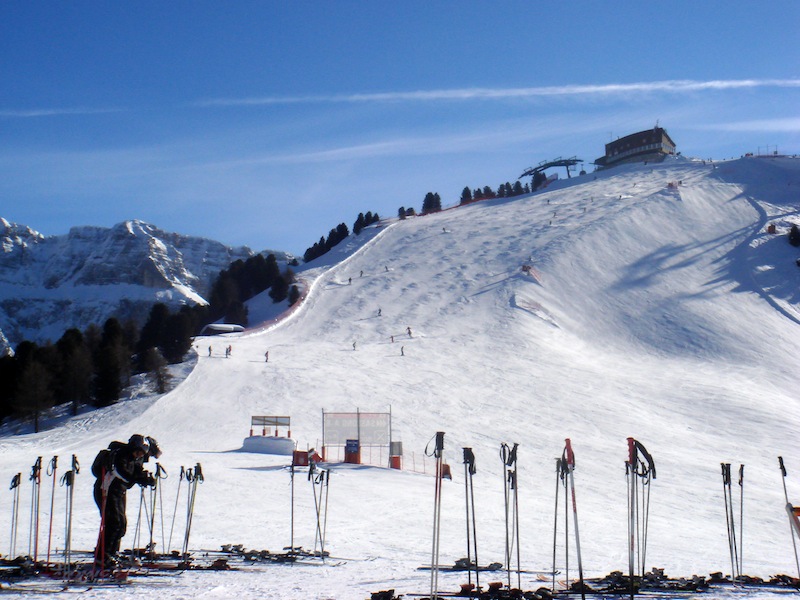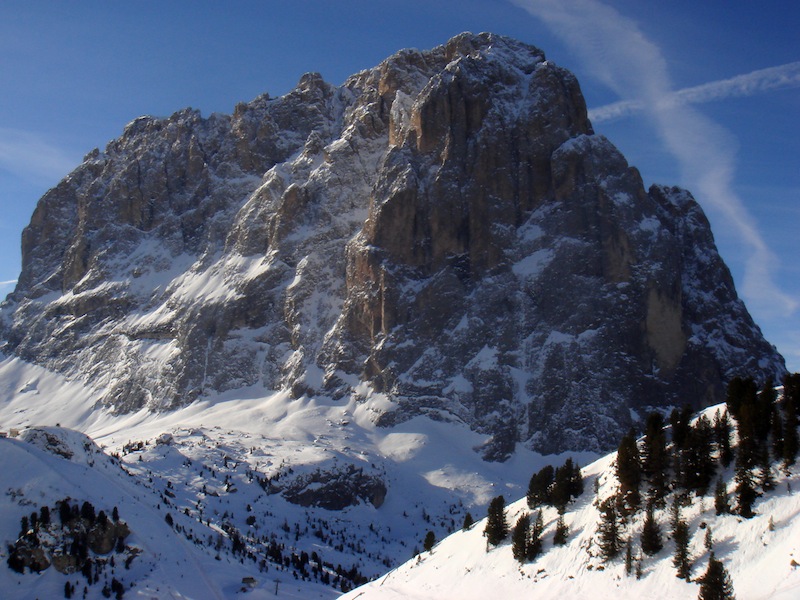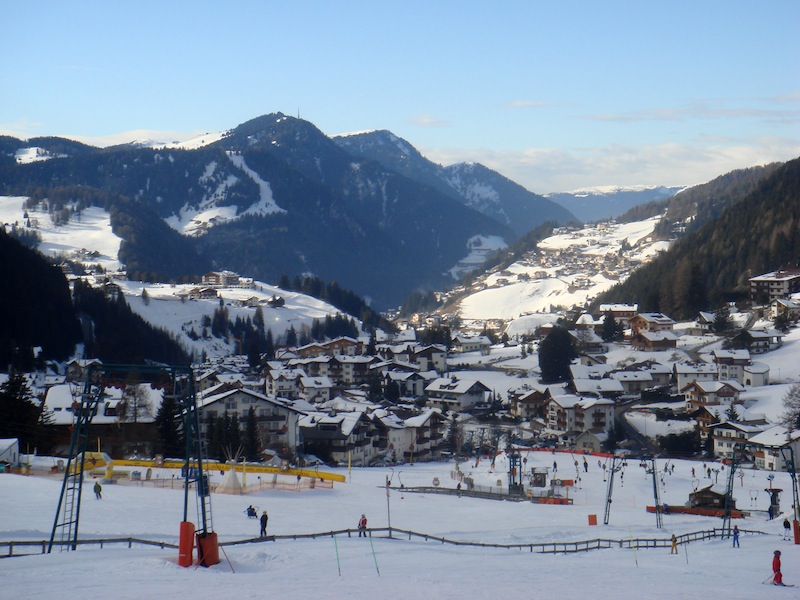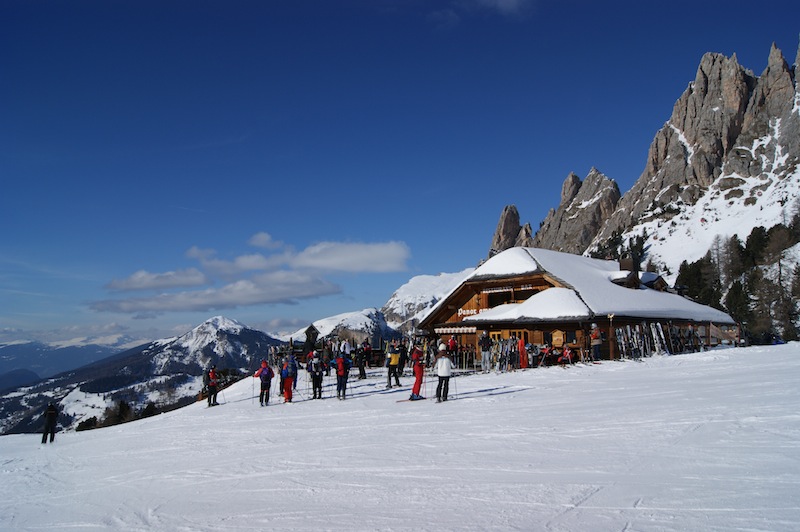I’d been away from the ski slopes for many years despite my love of the mountains in winter. But with Graham ready to give the sport a go, we booked a week in the Italian Dolomites for a week of the white stuff.
Selva lies at the head of the beautiful Val Gardena in northern Italy, a valley that should be familiar to fans of BBC TV’s Ski Sunday. For decades it’s hosted a World Cup men’s downhill every December and this holiday would give me the opportunity to ski the famous course.
That was the theory anyway. As we arrived in the resort fresh from a flight to Verona, our coach got stuck on a hill, leaving us stranded in the cold and gloom. Suffering from an upset stomach, which would rumble on for days, all I wanted to do was curl up in bed in a warm hotel room, not wait for the coach driver to fix the mess he’d found himself in.

That illness made me rather nervous about joining ski school, especially as Graham would be elsewhere in his beginners’ class. How would I cope in the middle of nowhere if my guts decided to give way? But in the end I crossed my legs and fingers, put myself through the start-of-the-week test and discovered that my ski legs were pretty much intact – thanks in part to a session or two we’d had at the Milton Keynes indoor ski centre.
I couldn’t believe how easy I found it, or how confident I felt on the slopes. Years back when I used to ski regularly I lacked the balls to push myself at speed or down steep slopes and I couldn’t work out where this new-found courage had come from. I needn’t have been nervous about the group either. Mostly female and including a great bunch from back in the UK who were about my age, we supported and encouraged each other during our lessons. Our instructor pushed us just enough too, never to the point where I felt I’d freeze.
Selva is about 1,500m above sea level so in theory should have a great snow record but historically this part of the Dolomites has often struggled with snow while the rest of the Alps has been deluged with it, and it was a bit thin in places during our stay. Still, it was regularly topped up with the artificial stuff, particularly the nursery slopes in the heart of the village where Graham tried to conquer his nervousness over the course of the week.

The village falls within the vast Dolomiti Superski area and it’s possible to head out to the villages of Canazei and Campitello or ski clockwise or anti-clockwise on the famous Sella Ronda ski tour. Despite skiing with all that confidence and really enjoying myself, I decided against putting myself through it on the day chosen by our instructor. Instead I sat in a mountain restaurant with beer and pasta and relished the scenery, the sun glinting off the snow and the majestic, purple-tinged peaks that make the Dolomites so exceptional.
I did, however, ski the World Cup downhill run – the black Saslong – with the group. In truth it’s nowhere near as steep and hair-raising as the Hahnenkahm in Kitzbuhel, which we once struggled to actually walk down. But then I wasn’t hurtling down it at 90mph in an unflattering skin-tight suit. The world’s best do it in 2 minutes. I did it in about 15.

The run ends in the little village of Santa Cristina, a short way down the valley from Selva. While the scenery throughout the valley is to die for, Selva itself isn’t the prettiest village I’ve stayed in – but neither is it a drab, purpose-built resort. There are shops to explore, restaurants to visit, some bars and plenty of woodcarving workshops, which are evidence of a famous tradition of the Val Gardena.
The area does have a bit of an identity crisis and the road signs are evidence of it. Some of them are three times bigger than they would otherwise be because three languages are spoken in the region. There’s Italian, obviously, but German too – a hangover from the time when the remote valley was controlled by generations of German aristocrats. And then there’s Ladin, a language spoken in some of the more remote mountain valleys of the Dolomites. That’s why Selva is also Wolkenstein in the Groden valley.
It makes ordering beers in the local bars challenging.

We stayed on the edge of the village in the attractive Hotel Continental up near the Dantercepies gondola, at the top of the nursery slopes. It was great for the quality of its food and getting to the lifts in the morning but, being at the top of a hill, it was a punishing trek home after an evening in the bars.
We went out most evenings to seek out the apres ski but to be honest, the village was a quiet place when we were there. A few bars in the centre were lively enough and we usually found ourselves in the busy Luislkeller with a mainly German crowd. There was no dancing, no ludicrously late nights.
And that – after my often dodgy belly, a visit to the doc’s and an injection of antibiotics in the rear end – was all I really wanted.

